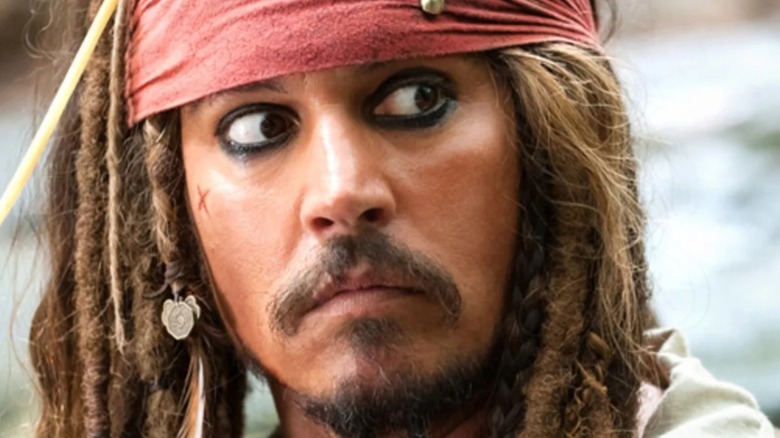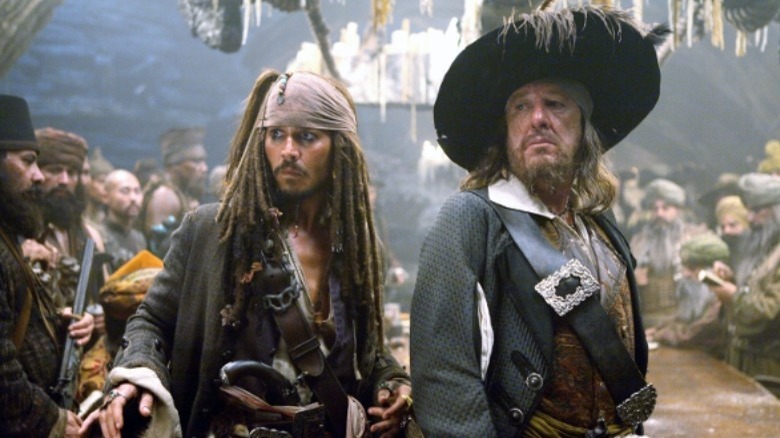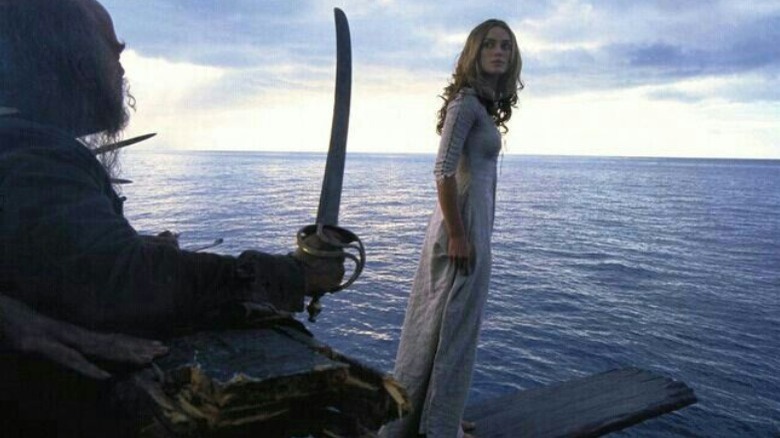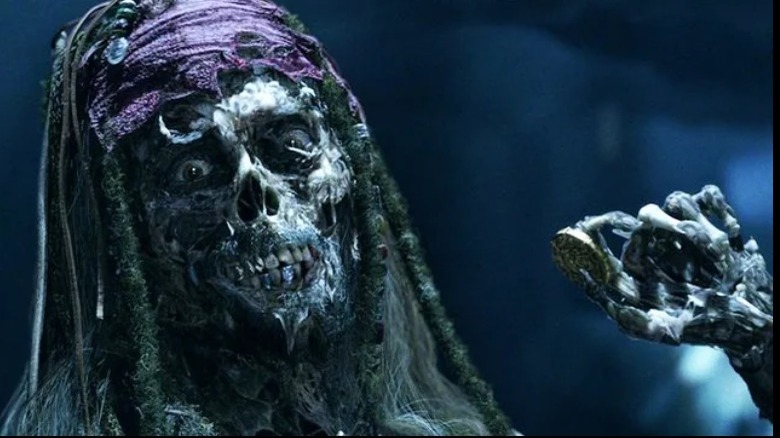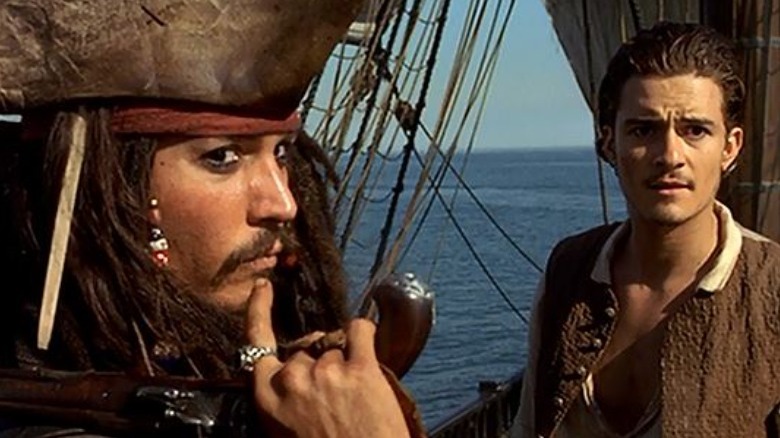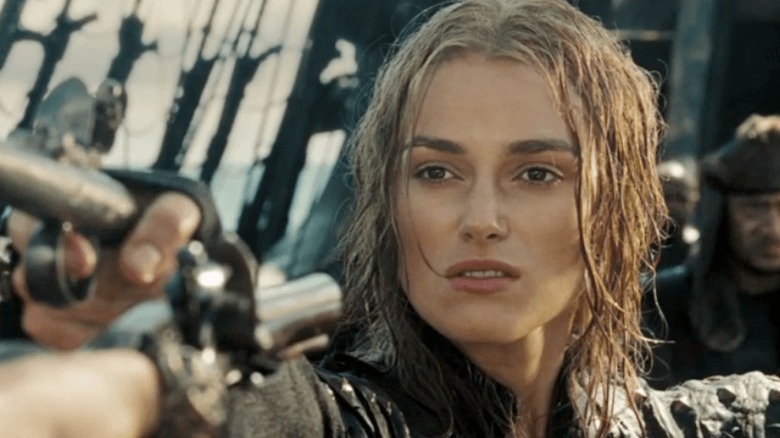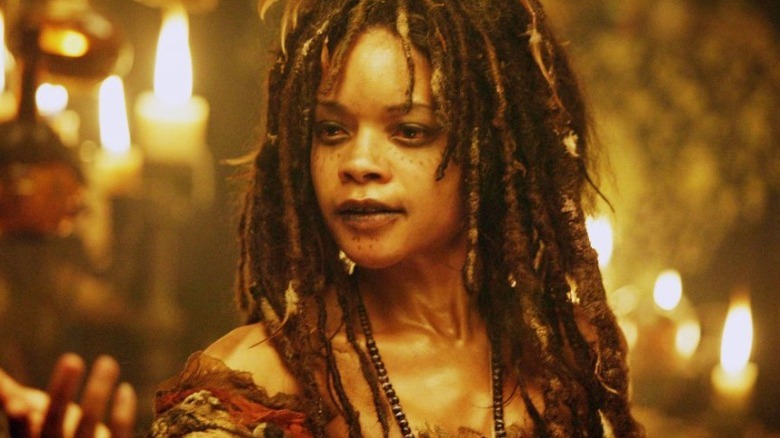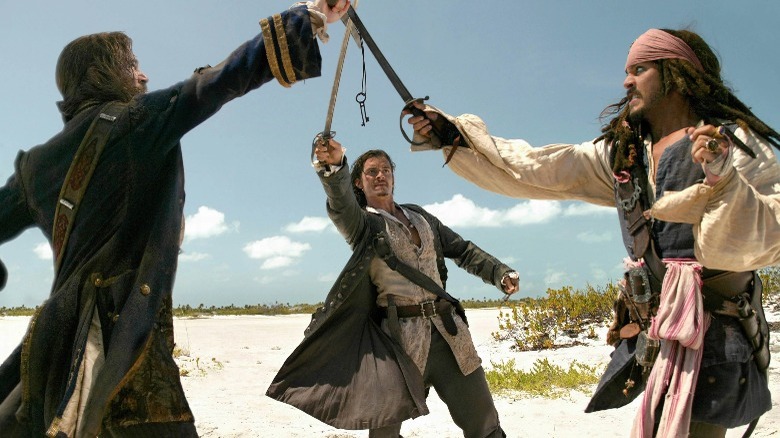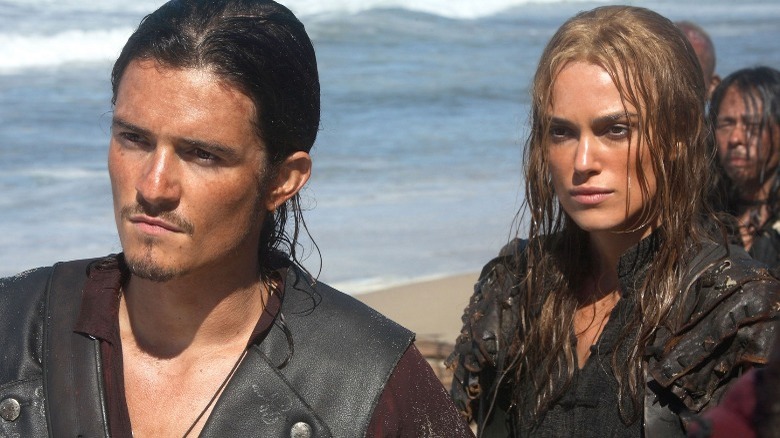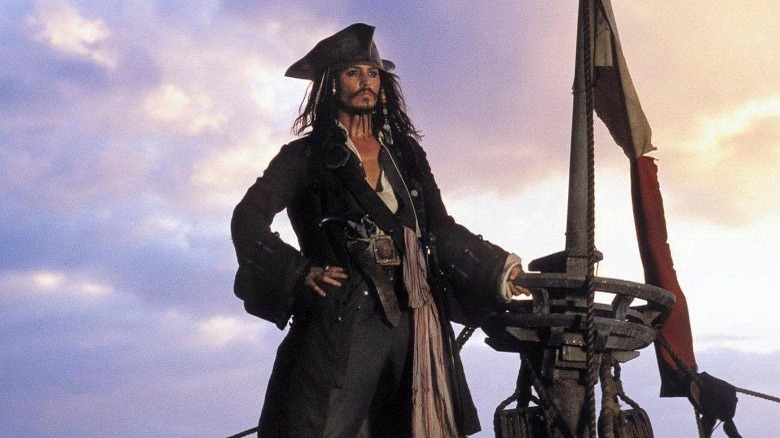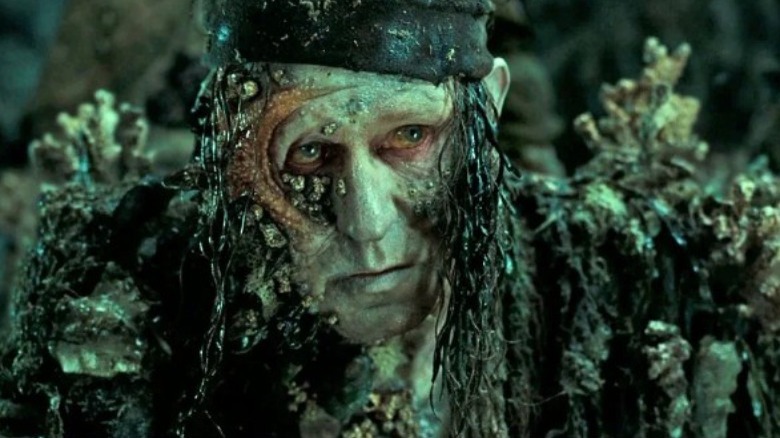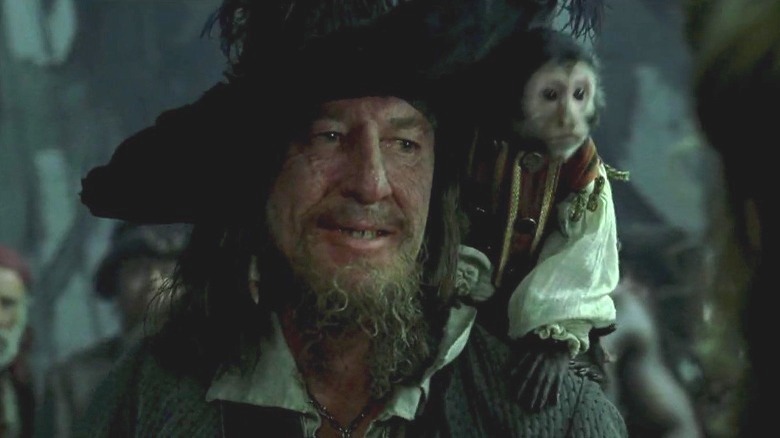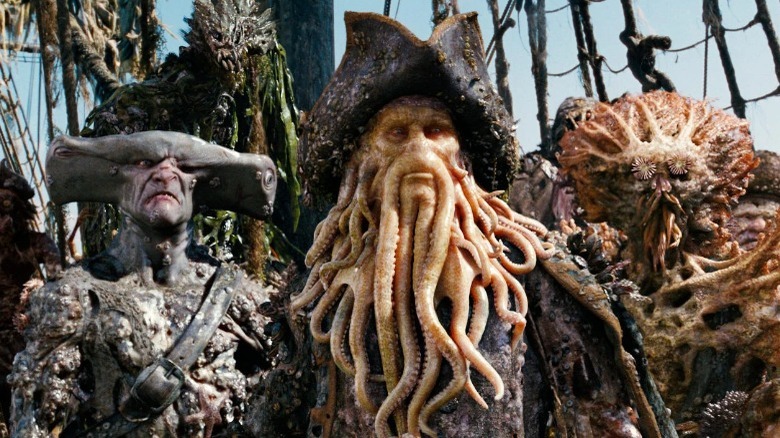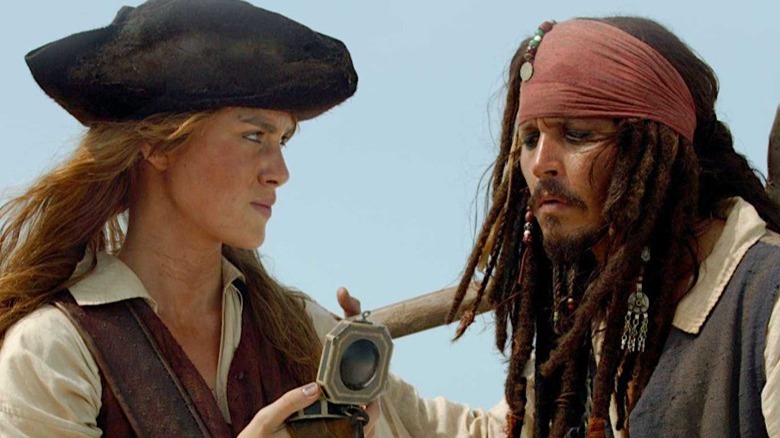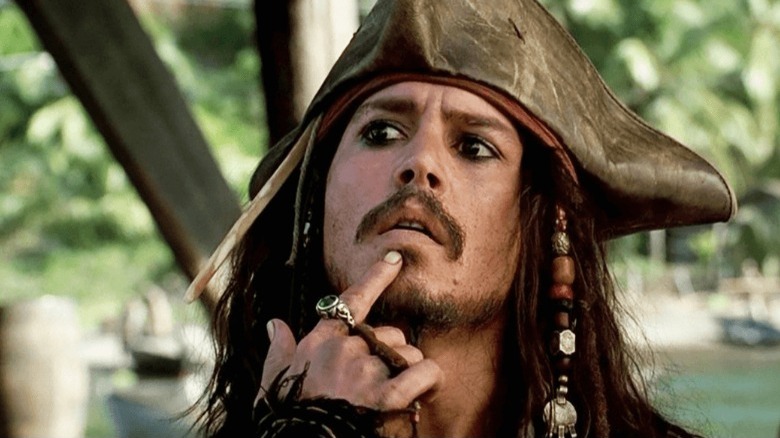The Best And Worst Things In The Pirates Of The Caribbean Franchise
What began as a movie based on a theme park ride soon evolved into a multi-billion film franchise that is one of the most successful movie series ever made. Starring Johnny Depp, Orlando Bloom, Keira Knightley, Geoffrey Rush, and a host of other Hollywood stars, "Pirates of the Caribbean" brought back the pirate genre with a bang.
The first film, "Pirates of the Caribbean: The Curse of the Black Pearl," was so popular that it quickly spawned a number of sequels, bringing the total number of entries in the series to five. While the subsequent movies have been more controversial than the original and less well-received by critics, all of them have been box office hits and continued to draw in fans around the world.
Like all movie franchises, "Pirates of the Caribbean" has had its fair share of good and bad moments. Some elements of the series are truly outstanding, while others leave a lot to be desired. Here we'll look at the best and worst things in the hit pirate phenomenon to see what it does well and where it can improve.
Best: It was a fresh new franchise
In a world of blockbuster sequels and reboots, "Pirates of the Caribbean: The Curse of the Black Pearl" stood out as something of a risk for Disney. Radio Times examined the highest-grossing movies from the last 40 years and found that there had been a remarkable increase in the number of sequels and remakes in that time, with the most expensive and successful movies generally being part of a franchise rather than an original release.
Disney bucked that trend in 2003 when they released the first "Pirates" film, although admittedly it later become a franchise in its own right. The series was not based on a pre-existing movie series but rather adapted from a ride at Disneyland also called "Pirates of the Caribbean." Of course, the attraction doesn't have much in the way of a story, although certain elements in the film were lifted from the ride. These included the skeleton pirates and the prison dog holding keys.
The company went through a phase of making movies based on its theme park rides in the early 2000s. However, the likes of "The Country Bears" proved unsuccessful, grossing just $18 million at the box office according to Box Office Mojo. What helped "Pirates of the Caribbean: The Curse of the Black Pearl" is that it was very different from Disney's usual releases, featuring a darker, more mature story alongside horror elements.
Worst: The historical inaccuracies and continuity mistakes
The "Pirates of the Caribbean" movies take place right at the peak of piracy in the 18th century, but they are not entirely accurate when it comes to history. For example, Royal Navy sailors are shown wearing uniforms, even though NPG reports they were weren't widely adopted until the early 19th century.
There are other historical problems as well. Port Royal is a thriving Jamaican town in the films but the city was largely destroyed by an earthquake in 1692, according to History.com. Similarly, an article from The Way Of The Pirates outlines how Tortuga had largely stopped being a haven for buccaneers and pirates in the 17th century, and would not have been the bustling pirate base it is depicted as. Finally, despite its usage in the franchise and other pirate films, History explained that pirates rarely made anyone walk the plank.
In terms of continuity errors, the "Pirates of the Caribbean" films have their fair share. One prominent example is Will Turner, who can be seen sporting a tattoo written in J.R.R. Tolkien's Elvish language. Actor Orlando Bloom got the tattoo in real life, with the rest of the cast, to commemorate his time in "The Lord of the Rings" film trilogy, and showed it off in a 2020 reunion on YouTube.
Members of the crew can also be seen in some shots, including a man wearing a white T-shirt and cowboy hat. Meanwhile, the pirate ships miraculously appear to repair themselves after battles, seemingly in pristine condition seconds after appearing to suffer major damage.
Best: It revitalized the pirate genre
In early Hollywood, pirate movies were all the rage. The BBC reports that the rogues were romanticized in books and plays long before the invention of movies, making them a popular choice for filmmakers. From the 1920s to the 1950s, there were a multitude of successful pirate movies, including the likes of "The Black Pirate" and "Captain Blood," which starred Douglas Fairbanks and Errol Flynn respectively.
However, South Coast Today explains that by the 1960s, the popularity of the genre had waned. A succession of box office flops and critically panned pirate movies effectively killed off the genre. Outside of a few notable exceptions, such as "The Goonies," "Hook," "The Princess Bride," and "Muppet Treasure Island," there were very few pirate films released up until the launch of "Pirates of the Caribbean: The Curse of the Black Pearl."
Not only did the "Pirates" films include all the best elements from the pirate movies of old, such as the sense of adventure and great sword fights, but they also introduced some new things. Captain Jack Sparrow is not the burly or buff action hero that you'd expect, while the inclusion of the undead pirates and Davy Jones' crew of mutated sailors helped the franchise stand out. All this contributed to the franchise becoming one of the biggest of all time.
Worst: Depicting pirates as good guys
Most pirate movies depict their subject with a sense of romance and adventure, with the seafaring rogues largely being swashbuckling heroes rather than downright villains. The "Pirates of the Caribbean" movies are no different in that respect. In fact, in some ways, they go even further to glamorize piracy — with the captains and crew often shown as following a code of honor while standing up for concepts such as freedom and democracy.
Real pirates were not all terrible people and, as shown in this LA Times article from 1998, did have some positive qualities. They would elect their captains, fairly share treasure, and even offer a life of freedom to slaves. Yet this doesn't tell the whole story. Pirates were undoubtedly bad guys, with the likes of Blackbeard proving to be brutal and cruel in equal measure, according to National Geographic.
So despite being what the Royal Museums Greenwich described as ordinary people who turned to piracy as a means to survive, pirates stole goods and valuables from innocent traders, using force if necessary. Some pirates were even known to kill their victims in unimaginably barbaric ways. Roche Braziliano was believed to have roasted Spanish farmers alive, while there are also recorded instances of woodling, where a person's eyes were popped out of their skull by wood being twisted around their heads.
Best: Established Keira Knightley as a star
Arguably one of the best things that the "Pirates of the Caribbean" franchise did was launch Keira Knightley on the world stage as a leading actress. According to The Scotsman, Knightley knew she wanted a job in acting from a young age and had an agent since she was six years old. She quickly started to get work in commercials and on television but didn't rise to prominence until she was cast in "Star Wars: Episode I – The Phantom Menace" as Sabé, a character who acts as a decoy and servant of Natalie Portman's Padmé Amidala.
She later had a starring role in the 2002 sports film "Bend It Like Beckham" alongside Parminder Nagra. But despite being a financial success and a minor hit in the UK, it was not hugely popular around the world with a box office gross of just $76 million. Cast in "Pirates of the Caribbean: The Curse of the Black Pearl" when she was just 17, even she had doubts about whether the film would be a success.
Speaking to CBS, Knightley explained how the film's premise made it difficult to gauge. She was also worried about being replaced as she was a relative unknown next to Hollywood stars such as Johnny Depp and Orlando Bloom. Returning to the series for the two sequels, she became a recognized actress around the world and has since appeared in a huge array of movies including "Pride and Prejudice," "The Imitation Game," and "The Duchess."
Worst: They go on for far too long
While the first film in the original trilogy wasn't exactly short, it never feels like it is overly long. Binge Clock reports that "Pirates of the Caribbean: The Curse of the Black Pearl" lasts for 143 minutes, which puts it very much in the range of other blockbusters such as "The Avengers," "Skyfall," and "Spider-Man: No Way Home." In fact, the movie sits just a little higher than the average running time calculated by Insider for the highest grossing film, which is 141 minutes. Of course, "Pirates of the Caribbean: The Curse of the Black Pearl" uses every minute of that run time and doesn't drag on.
The same can't be said for the two sequels. "Pirates of the Caribbean: Dead Man's Chest" and "Pirates of the Caribbean: At World's End" clock in at 150 and 168 minutes respectively. That means watching the second and third installments in the franchise would take almost five and a half hours. This is often the result of set pieces and action sequences that go on too long and don't really advance the story or add anything other than looking pretty. Some of that could have been sacrificed to create a tighter and more focused set of sequels that didn't take an age to watch.
Best: Spectacular action sequences and great special effects
One thing that is essential for any pirate films are great action sequences. Whether it is epic sword fights, thunderous naval battles, or frantic chases, the "Pirates of the Caribbean" series has plenty of impressive and exciting moments to keep your pulse racing. That makes them true swashbuckler films that harken back to the golden age of the pirate genre.
Just look at scenes such as the maelstrom naval battle in "Pirates of the Caribbean: At World's End" or when the crew escapes from the cannibal island while being chased by the locals in "Pirates of the Caribbean: Dead Man's Chest." There are numerous impressive fights as well, including the first between Captain Jack Sparrow and Will Turner and the three-way encounter between those two and James Norrington when they battle it out to get Davy Jones' key.
Meanwhile, the special effects made the various otherworldly characters and items appear as realistic as possible. The team at Industrial Light and Magic created stunning computer-generated characters using state-of-the-art motion capture technology, bringing the skeleton crew of the Black Pearl to life in a convincing way. They also managed to create the tentacle-faced Davy Jones, who EW called "more real ... than any CG character in history."
Worst: Replacing major characters with forgettable ones
Part of the charm of the first three "Pirates of the Caribbean" movies are the characters that were first introduced in the original 2003 film. While Captain Jack Sparrow has been a constant throughout the entire series, alongside the ever-excellent Geoffrey Rush as Captain Hector Barbossa, there are plenty of other great characters in the original trilogy. The likes of Will Turner and Elizabeth Swann are essentially the main characters of the first three films, while Pintel and Ragetti also play an important role.
Things changed somewhat in "Pirates of the Caribbean: On Stranger Tides" and "Pirates of the Caribbean: Dead Men Tell No Tales." The two main characters of WIll and Elizabeth were no longer present, replaced with a cast that included Penélope Cruz's Angelica and Brenton Thwaites' Henry Turner. They simply didn't have the same impact as the older characters, who had proper introductions in "Pirates of the Caribbean: The Curse of the Black Pearl" and evolved over the course of the first three films. The lack of Pintel and Ragetti also meant that some of the best comic relief from the series was missing and not adequately replaced.
Best: There are genuinely funny moments throughout
While the "Pirates of the Caribbean" movies are not comedies, they do contain quite a lot of funny moments and great jokes. A lot of this comes from Captain Jack Sparrow himself (according to Tor) and Gibbs, two characters who often have a witty one-liner on hand or find themselves in a comedic situation of their own making. Sparrow's very introduction to the series is genuinely funny, as his boat just about stays afloat as he arrives in Port Royal. The pirate also has some great interactions with Captain Barbossa, especially when it comes to the two comparing their telescope sizes.
Unfortunately, this humor largely faded after the original trilogy, with the subsequent movies attempting to be more overtly funny but failing to hit the right note. They weren't helped by omitting the likes of comic relief characters like Ragetti and Pintel or Murtogg and Mullroy. These two duos played an essential role in bringing some lighter moments to the series, with Ragetti and Pintel's absence from the two most recent releases being particularly difficult. Actors Lee Arenberg and Mackenzie Crook were able to make the audience laugh throughout the first three films — why lose that?
Worst: The stories get weirder and more confusing
As far as pirate films go, "Pirates of the Caribbean: The Curse of the Black Pearl" had a rather complex plot that involved an Aztec curse, undead pirates, a pursuing Royal Navy force, and a character in Captain Jack Sparrow that audiences could never be sure whose side he was ever truly on. But it was coherent and viewers could follow it relatively easily. Unfortunately, the plots of the subsequent movies only became more confusing and harder to keep track of as time went by.
A major complaint of all the "Pirates of the Caribbean" films, outside of the original release, is that they are convoluted and overly difficult to follow. There is simply too much going on with so many different characters doing their own things and multiple stories to follow. The Hollywood Reporter suggests this may have been a result of Disney rushing to get the sequels out following the success of the first film, resulting in bloated, needlessly complicated scripts that the screenwriters didn't have time to refine before filming.
This is a point that even Johnny Depp picked up on. Speaking to Empire magazine (reported by NME), the actor explained that the second and third films "became quite... sub-plotty" and that some people had to see them "two or three times just to figure out what was happening." This was obviously a major problem and something that stopped the audience from being able to fully enjoy the movies.
Best: Great performances from the cast
Even with the great story, impressive visual effects, and exciting set pieces, what makes the "Pirates of the Caribbean" franchise so successful is undoubtedly the terrific performances of the cast. The series has seen its stars lauded for their roles across all the movies but particularly in the first three. IMDb lists dozens of award nominations, with Johnny Depp leading the way for his role as Captain Jack Sparrow.
His original take on the role of a pirate drew plaudits from Roger Ebert, who also praised the performance of Geoffrey Rush and the interactions between the pair. Of course, Keira Knightley also made a name for herself thanks to her acting, while many other actors put in memorable performances, including Jack Davenport as James Norrington, Kevin R. McNally as Joshamee Gibbs, and Jonathan Pryce as Governor Weatherby Swann.
In the two immediate sequels, EW pointed out that Bill Nighy was noteworthy for his part as the villainous and monstrous Davy Jones. He may even have eclipsed Captain Barbossa as the best villain in the series thanks to his truly scary presence.
Worst: They aren't exactly family-friendly
Most people might assume that a pirate film from Disney would be something that the whole family could enjoy. Yet the "Pirates of the Caribbean" series has always had something of a dark element present. As Polygon notes, the first film is built around its horror themes, with zombie-like skeletal pirates shown in all their gruesome glory. There are also some pretty shocking and grotesque moments, such as when one of the undead pirates is blown up with a grenade or when Captain Barbossa's crew silently murders many of the Royal Navy sailors pursuing them by slitting their throats.
The sequels have their own terrifying moments as well. Just look at the horrifying appearance of the crew of the Flying Dutchmen, who have become part human and part sea creatures. Meanwhile, "Pirates of the Caribbean: At World's End" opens with a group of pirates being hanged, including a young child. Villain Ian Mercer also dies in a brutal way, as Davy Jones sends his tentacles into the man's head, with the limbs coming out of his mouth and nose. All of this doesn't exactly make for child-friendly viewing.
Best: There are strong female leads
Unlike many action films, which generally relegate female characters to being mere love interests or sideline them away from the best moments, the "Pirates of the Caribbean" franchise has put its female characters at the forefront. As Polygon notes, Elizabeth Swann is central to the story throughout the first three movies and arguably the most important character in the narrative. She quickly evolves from the daughter of a governor to a pirate, eventually leading the Pirate Lords of the Brethren Court to war.
Swann doesn't just get involved in the action herself but she is able to outmaneuver and outsmart the other leading characters, tricking the likes of Captain Jack Sparrow in "Pirates of the Caribbean: Dead Man's Chest." The character stands up for herself and isn't afraid of conflict with fearsome admirals or pirate captains.
But it isn't just Keira Knightley's role that put women in positions of power. Naomie Harris portrayed the goddess Calypso in the two immediate sequels, while Penélope Cruz played the capable Angelica in "Pirates of the Caribbean: On Stranger Tides" and Kaya Scodelario took on the role of the headstrong Carina Smyth Barbossa in "Pirates of the Caribbean: Dead Men Tell No Tales." It seems Disney is aware of the importance of female characters in the series, with the Hollywood Reporter revealing that Margot Robbie is going to lead her own "Pirates of the Caribbean" film.
Worst: Captain Jack becomes the main character and devolves
In the first film of the series, Captain Jack Sparrow is not the main character. The two protagonists are Will Turner and Elizabeth Swann, with Sparrow taking on a supporting role. Although he has a lot more screen time than you would expect from a secondary character, the wacky pirate doesn't play a huge role in the overall story. The massive popularity of Sparrow, however, meant that he took more of a central role in the sequels, becoming the main character at the expense of Turner and Swann (according to Polygon).
This meant that Sparrow's bizarre and eccentric behavior rose to prominence and overshadowed everything else. The negative consequences of this shift in focus led to less attention being paid to the relatable human characters who pushed the narrative forward. Turner and Swann's story was sacrificed so the films could feature more of Sparrow's antics.
Things got even worse in the final two movies, when Captain Jack Sparrow became a parody of himself. In the original trilogy, Sparrow seems at first to not know what he's doing, but it's clear that he has a plan in his head, even if he does improvise quite a lot. "Pirates of the Caribbean: On Stranger Tides" and "Pirates of the Caribbean: Dead Men Tell No Tales," however, depict Sparrow as a bumbling fool who fortuitously and miraculously manages to come out on top, like Mr. Magoo or Mr. Bean. He effectively becomes the clown that everyone mistakenly thought he was in the original trilogy.
